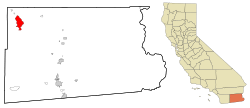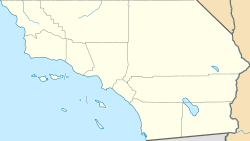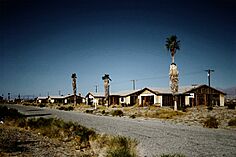Salton City, California facts for kids
Quick facts for kids
Salton City
|
|
|---|---|

Location in Imperial County and the state of California
|
|
| Country | United States |
| State | California |
| County | Imperial |
| Area | |
| • Total | 21.431 sq mi (55.506 km2) |
| • Land | 21.431 sq mi (55.506 km2) |
| • Water | 0 sq mi (0 km2) 0% |
| Elevation | -125 ft (-38 m) |
| Population | |
| • Total | 5,155 |
| • Density | 240.539/sq mi (92.873/km2) |
| Time zone | UTC-8 (Pacific) |
| • Summer (DST) | UTC-7 (PDT) |
| ZIP code |
92275
|
| Area code | 442/760 |
| FIPS code | 06-64294 |
| GNIS feature IDs | 1853413, 2409242 |
Salton City is a census-designated place (CDP) in Imperial County, California. It is the largest Imperial County development on the Salton Sea coast. It is part of the El Centro, California Metropolitan Statistical Area. The population was 3,763 at the 2010 census, up from 978 in 2000. The reported population for 2020 was 5,155.
Although planned and developed as a large resort community with an extensive road, water, sewer and power grid capable of supporting 40,000 residents on 12,000 residential lots, demand for property in Salton City fell drastically short of the planners' expectations. According to the 2010 census, 81% of the surveyed lots in Salton City remain undeveloped, and 38% of the habitable residences in Salton City are unoccupied. Despite Salton City's higher population compared to nearby Salton Sea communities such as Bombay Beach and Desert Shores, the eerie, mostly-abandoned appearance of the area has led some to call it a modern ghost town.
History
Salton City was developed in the 1960s and established in 1958 primarily by M. Penn Phillips and the Holly Corporation, the Texas-based oil refiner and land developer. It was intended to be a resort community on the Salton Sea, a saline, endorheic rift lake located directly on the San Andreas Fault, yet by 1965 limited development was achieved due to its isolation and lack of local employment opportunities and the downfall of the town began.
In the 1970s, most of the buildings constructed along the shoreline, including the city's marina were abandoned due to rising sea elevation. In the 1980s, the Imperial Irrigation District took proactive water conservation measures to reduce the flow of unused canal water into the Salton Sea. Throughout the 1980s and 1990s, as salinity and suspected pollution levels in the Salton Sea increased, the attraction of the Salton Sea as a recreational destination diminished. Most of the original tourist related structures fell during this time, including the Truckhaven Cafe, the Salton Bay Yacht Club hotel and restaurant, and the Holly House motel and restaurant (later renamed Desser House and then the Sundowner).
In the 2000s, development in Salton City began to rise as a result of the escalating California housing market. Cheap land and housing costs, improvements to Highway 86, and a casino opened by Torres-Martinez Desert Cahuilla Indians attracted new residents.
Geography
According to the United States Census Bureau, the CDP has a total area of 21.1 square miles (55 km2), all land. This area makes Salton City the largest city or town in terms of land area in the Imperial Valley.
Salton City is located on relatively flat ground. Several washes flow from the mountains to the west creating small gorges where any flowing run-off will drain into the Salton Sea. The vegetation consists of mostly sparse desert shrubs; however, in developed areas a variety of palm trees as well as other deciduous trees survive. Salton City is positioned between the eastern slope of the Peninsular Ranges and the western coast of the Salton Sea.
Earthquakes are an extremely common occurrence around the Salton Sea, and in Salton City, due to dozens of fractured fault lines that run through Imperial County. Salton City is also mere miles from major, destructive fault lines, such as the Imperial Fault, the San Andreas Fault, and the San Jacinto Fault. The Superstition Faults also pose a major risk to the area, as well as the Brawley Seismic Zone, which produces frequent yet mostly non-damaging earthquake swarms. At certain times, this area can experience dozens of felt earthquakes in a time period lasting from one day to over one week. Most of the earthquakes are minor to moderate and pose no hazard due to strict seismic codes; however, the area is notorious for earthquake swarms and other major seismic events. The San Andreas Fault begins at Bombay Beach where the southern terminus of the San Andreas transitions into the Brawley Seismic Zone, about ten miles across the Salton Sea from Salton City. Most residents are fully accustomed to minor and moderate earthquakes, but are prepared for a large one.
To the north of the CDP are Salton Sea Beach and Desert Shores. Salton City is approximately 50 miles (80 km) from the Imperial County seat of El Centro and 110 and 115 miles respectively from the coastal San Diego County cities of Oceanside and San Diego.
Climate
This area has a large amount of sunshine throughout the year, due to the amount of descending high pressure aloft. According to the Köppen Climate Classification system, Salton City has a hot desert climate. However, Salton City experiences its own microclimate due to the proximity of the warm lake waters. Humidity is significantly higher along the shore during the warmer months, from May through September. Its climate can mimic a tropical climate at times, with exceptionally high dewpoints for an arid desert, but this typically happens for only a part of the day, or a few days in a row at the most. Once winds prevail from the northwest, the climate is similar to other areas in Imperial County that are not along the Salton Sea. Salton City itself is extraordinarily dry, and did not measure an inch of rain between September 2016 and August 2021. Any rain is rare, and even moderate rain can cause road closures, roads washed out, and other damage. The area is not equipped to handle any rainfall.
| Climate data for Salton City, CA | |||||||||||||
|---|---|---|---|---|---|---|---|---|---|---|---|---|---|
| Month | Jan | Feb | Mar | Apr | May | Jun | Jul | Aug | Sep | Oct | Nov | Dec | Year |
| Record high °F (°C) | 96 (36) |
96 (36) |
104 (40) |
117 (47) |
124 (51) |
126 (52) |
125 (52) |
124 (51) |
126 (52) |
111 (44) |
98 (37) |
90 (32) |
126 (52) |
| Mean daily maximum °F (°C) | 67.8 (19.9) |
73.8 (23.2) |
79.4 (26.3) |
85.1 (29.5) |
93.9 (34.4) |
102.6 (39.2) |
105.7 (40.9) |
105.4 (40.8) |
101.0 (38.3) |
90.3 (32.4) |
78.2 (25.7) |
68.8 (20.4) |
87.7 (30.9) |
| Mean daily minimum °F (°C) | 39.4 (4.1) |
44.8 (7.1) |
49.4 (9.7) |
57.1 (13.9) |
61.6 (16.4) |
68.8 (20.4) |
76.6 (24.8) |
77.0 (25.0) |
70.8 (21.6) |
59.6 (15.3) |
47.9 (8.8) |
38.4 (3.6) |
57.6 (14.2) |
| Record low °F (°C) | 22 (−6) |
22 (−6) |
30 (−1) |
35 (2) |
43 (6) |
50 (10) |
51 (11) |
60 (16) |
49 (9) |
36 (2) |
27 (−3) |
14 (−10) |
14 (−10) |
| Average precipitation inches (mm) | 0.43 (11) |
0.41 (10) |
0.34 (8.6) |
0.10 (2.5) |
0.04 (1.0) |
0.00 (0.00) |
0.13 (3.3) |
0.27 (6.9) |
0.30 (7.6) |
0.28 (7.1) |
0.20 (5.1) |
0.46 (12) |
2.96 (75.1) |
| Source: http://www.wrcc.dri.edu/cgi-bin/cliMAIN.pl?ca4223 | |||||||||||||
Demographics
Despite a long period of population decline, the population of Salton City has been increasing in recent years.
| Historical population | |||
|---|---|---|---|
| Census | Pop. | %± | |
| 1990 | 1,233 | — | |
| 2000 | 978 | −20.7% | |
| 2010 | 3,763 | 284.8% | |
| 2020 | 5,155 | 37.0% | |
| U.S. Decennial Census | |||
2010
The 2010 United States Census reported that Salton City had a population of 3,743. The population density was 175.6 inhabitants per square mile (67.8/km2). The racial makeup of Salton City was 2,260 (60.1%) White, 80 (2.1%) African American, 61 (1.6%) Native American, 61 (1.6%) Asian, 5 (0.1%) Pacific Islander, 1,159 (30.8%) from other races, and 137 (3.6%) from two or more races. There were 2,368 Hispanic or Latino people of any race (62.9%).
The Census reported that 3,763 people (100% of the population) lived in households, 0 (0%) lived in non-institutionalized group quarters, and 0 (0%) were institutionalized.
There were 1,204 households, out of which 513 (42.6%) had children under the age of 18 living in them, 653 (54.2%) were opposite-sex married couples living together, 134 (11.1%) had a female householder with no husband present, 91 (7.6%) had a male householder with no wife present. There were 67 (5.6%) unmarried opposite-sex partnerships, and 12 (1.0%) same-sex married couples or partnerships. 269 households (22.3%) were made up of individuals, and 133 (11.0%) had someone living alone who was 65 years of age or older. The average household size was 3.13. There were 878 families (72.9% of all households); the average family size was 3.73.
The population was spread out, with 1,247 people (33.1%) under the age of 18, 350 people (9.3%) aged 18 to 24, 890 people (23.7%) aged 25 to 44, 813 people (21.6%) aged 45 to 64, and 463 people (12.3%) who were 65 years of age or older. The median age was 31.3 years. For every 100 females, there were 101.4 males. For every 100 females age 18 and over, there were 103.1 males.
There were 2,026 housing units at an average density of 94.5 per square mile (36.5/km2), of which 1,204 were occupied, of which 833 (69.2%) were owner-occupied, and 371 (30.8%) were occupied by renters. The homeowner vacancy rate was 18.0%; the rental vacancy rate was 20.3%. 2,425 people (64.4% of the population) lived in owner-occupied housing units and 1,338 people (35.6%) lived in rental housing units.
2000
According to the 2000 United States Census, 978 people, 416 households, and 267 families resided in the CDP. The population density was 45.2 inhabitants per square mile (17.5/km2). There were 730 housing units at an average density of 33.8 per square mile (13.1/km2). The racial makeup of the CDP was 73.6% White, 0.8% African American, 1.9% Native American, 0.6% Asian, 0.1% Pacific Islander, 17.4% from other races, and 5.5% from two or more races. 32.5% of the population were Hispanic or Latino of any race.
There were 416 households, out of which 21.4% had children under the age of 18 living with them, 51.4% were married couples living together, 8.2% had a female householder with no husband present, and 35.8% were non-families. 30.0% of all households were made up of individuals, and 19.7% had someone living alone who was 65 years of age or older. The average household size was 2.4 and the average family size was 2.9.
In the CDP, the population was spread out, with 20.9% under the age of 18, 5.7% from 18 to 24, 18.9% from 25 to 44, 24.1% from 45 to 64, and 30.4% who were 65 years of age or older. The median age was 49 years. For every 100 females, there were 91.4 males. For every 100 females age 18 and over, there were 92.5 males.
The median income for a household in the CDP was $21,563, and the median income for a family was $20,208. Males had a median income of $26,458 versus $4,886 for females. The per capita income for the CDP was $14,106. About 26.3% of families and 29.8% of the population were below the poverty line, including 71.8% of those under age 18 and 10.0% of those age 65 or over.
From 2004 to 2007, Salton City experienced a housing boom. Several hundred new houses were built.
See also
 In Spanish: Salton City para niños
In Spanish: Salton City para niños






